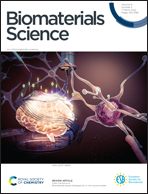Glioma-targeted multifunctional nanoparticles to co-deliver camptothecin and curcumin for enhanced chemo-immunotherapy†
Abstract
Camptothecin (CPT) is a potent broad-spectrum antitumor agent with efficient therapeutic effect for various cancers. However, its application in glioma therapy has been impeded by the tumor immunosuppressive environment and blood–brain barrier (BBB)-associated drug delivery challenges. Herein, neurotransmitter analogs-modified liposomes (NTs-LIP) were prepared by doping lipidized tryptamine (Tryp) to co-deliver CPT and curcumin (CUR) for improved chemo-immunotherapy in glioma. The introduction of Tryp promotes the delivery efficiency of CPT and CUR across the BBB. CPT inhibits cell proliferation after cellular uptake of NTs-LIP, the combination of which with CUR downregulates the elevated expression of the programmed cell death 1 ligand 1 (PD-L1) caused by CPT to prevent the inactivation of T-cells and synergistically enhance chemo-immunotherapy efficacy. Furthermore, both Tryp and CUR interfere with the indoleamine 2,3-dioxygenase (IDO) pathway to reduce regulatory T cell (Treg)-mediated immunosuppression, exhibiting the potential to combine with PD-L1 inhibition for synergistic antitumor immunity. Taken together, this platform contributes towards targeted delivery and alleviation of the immunosuppressive environment in glioma therapy.



 Please wait while we load your content...
Please wait while we load your content...